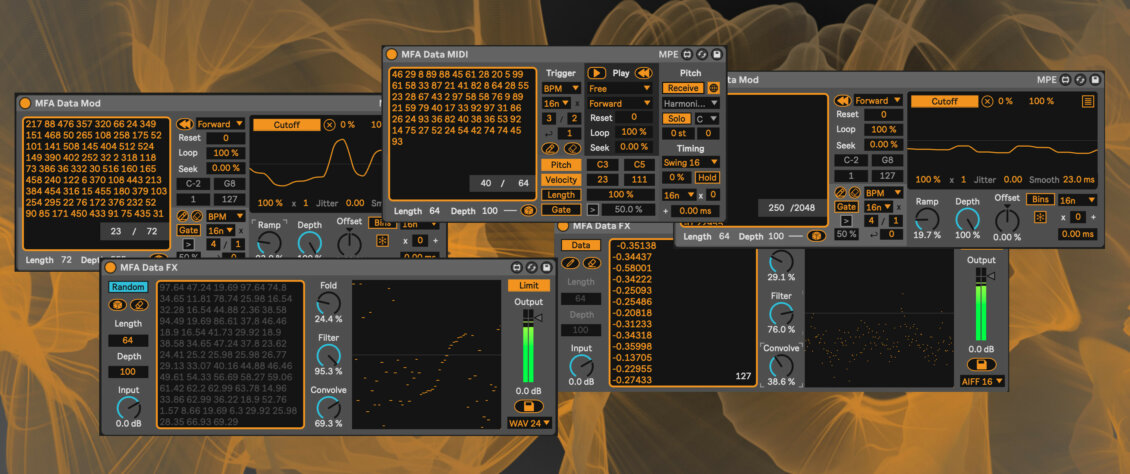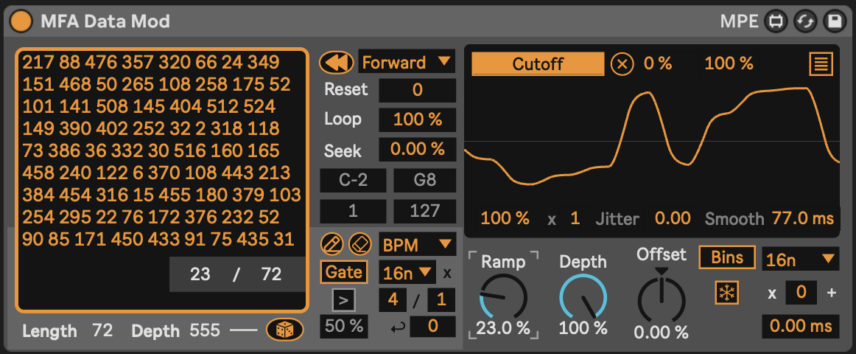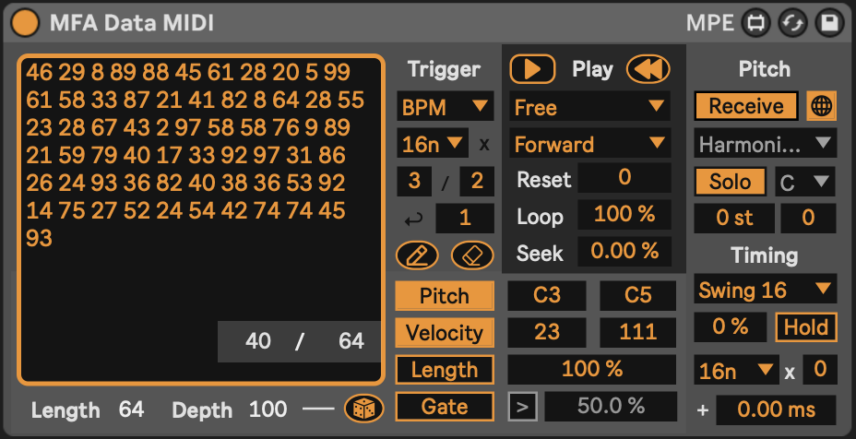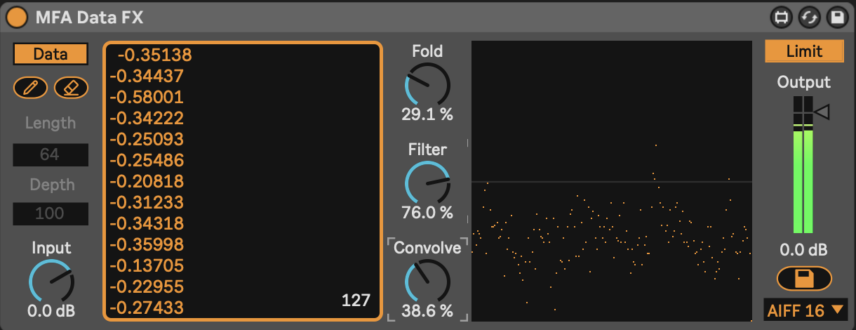CD, CD Çalar, DVD, DVD Çalar, SACD, LP, Plak Çeşitleri ve Fiyatları

Manifest Audio’s Sonification Tools open new realms of creativity for artists and producers.
Turning The World Into Sound
Until now, sonification remained an esoteric technique primarily available to artists with some form of coding background. But with the release of Sonification Tools, Berlin’s Manifest Audio offer an accessible solution to harness real-world data for music composition directly within Ableton Live.
This trio of new Max for Live devices allow users to integrate data-driven creativity into their music production process seamlessly. They can generate MIDI patterns, parameter modulation, and even WAV or AIFF files from raw numeric data. It’s as simple as copying and pasting your data, then tweaking away – and presents a fresh approach to music production and sound design.

[advert]
What is Sonification?
Sonification is the process of converting raw data or information into sound or music. Like infographics and other visualizations turn data into more easily digested visuals, sonification turns data into melodies, soundscapes and even compositions. Traditionally used to make data more accessible (especially for the visually impaired), sonification can also be used as an artistic method in its own right.
A recent example would be the Laser Interferometer Gravitational-Wave Observatory, or LIGO, which used sonification to transform gravitational wave data originating from cosmic events like black hole collisions into audible sounds.
As a creative tool, sonification can translate non-musical data into uniquely compelling musical motifs, with meaning embedded directly into the output. For example, you could harness data like market fluctuations, weather patterns, demographic trends, or scientific measurements, and turn these into sequences, chord progressions, effect automation, or ambient textures with a greater depth of meaning than your typical preset.
Many producers have used data from sources like climate statistics or commodities markets, converting them into melodies or rhythms to imbue their music with added layers of meaning. But the previously technical methods to achieve this have remained out of reach for most producers, until now.

[advert]
What Is Sonification Tools?
With Sonification Tools, you can easily enter numerical data by typing it in manually or simply copying and pasting from any data source: websites, spreadsheets, text files, you name it.
Once your data is entered, you can use it to generate MIDI patterns with Data MIDI, map modulation sequences to any parameter in your set with Data Mod, and apply spectral filtration, wavefolding distortion, impulse convolution, and, crucially, convert it to an audio waveform with Data FX.
The flexibility of these tools allows you to exert precise control over how data is expressed in your music. You can adjust pitch, velocity, length, timing, swing, loop, direction, gating, and more to achieve nearly any desired musical artefact based in your data set.
As with other Manifest Audio devices, you can impose a variety of musical scales on your MIDI data, ensuring it harmonizes with your composition. And if you don’t care or don’t have time to source data, all three devices let you randomize a random data string to easily begin experimenting from scratch.
At their core, Sonification Tools cater to users who want to experiment with data in their music – but they also offer new pathways to inspiration for those who may not have considered sonification in their work. Exploring the relationship between real-world phenomena and musical expression, Sonification Tools enable you to give real-world data a unique voice, producing meaningful musical narratives in the process.

[advert]
Why should producers care?
- Creativity and Innovation: Sonification offers an innovative approach to music composition, breaking away from traditional sound sources.
- Cross-Disciplinary Collaboration: Sonification bridges the gap between music and other fields, such as science, data analysis, and technology; collaborating with experts from these domains can lead to new and exciting ideas.
- New Expressive Possibilities: Sonification can convey complex ideas, emotions, and concepts through music: producers can use it to tell stories, evoke moods, or raise awareness about important issues by translating data into auditory experiences that resonate with listeners on a potentially deeper level.
- Audience Engagement: Sonification can pique the curiosity of listeners. When audiences discover that a piece of music is based on real-world data, they could become more engaged and interested in the underlying subject matter, fostering a deeper connection with the music and the artist that made it.
- Educational Value: Sonification can be an educational tool, helping to communicate scientific or abstract concepts in a more accessible and engaging manner. Producers can use music to make complex ideas more relatable and convey them to a wider audience.
- Sound Design Possibilities: By using unconventional data sources as sound generators, electronic music producers can create unique textures, rhythms, and atmospheres that they would not likely make with other tools.
- Artistic Challenge: Incorporating sonification into music production can be a creative challenge, pushing producers to think outside the box and experiment with different data-to-sound mappings, and entirely new creative processes.
[advert]
Where can I find good data?
Any website with reputable historical data sets will do, but here’s some examples to get you started:
- NASA
- Our World In Data
- NOAA
- Yahoo Finance
- Football Statistics & Reference
What’s Included?
Sonification Tools comes with three main Max for Live Devices:
- Data MIDI
- Data Mod
- Data FX
It also comes bundled with Utility Boost: a bonus pack of Max for Live audio and MIDI utilities.
Learn more on Manifest Audio.
Watch the in-depth walkthrough.
Sonification Tools are on sale with introductory pricing until 21 October 2023
Attack readers get an additional 10% off at checkout until the end of October 2023, enter the code:
SON-ATTACK-23
Want to learn more about Max for Live? Check out our Max for Live shop!
[social-links heading=”Follow Attack Magazine” facebook=”https://www.facebook.com/attackmag” twitter=”https://twitter.com/attackmag1″ instagram=”https://www.instagram.com/attackmag/” youtube=”https://www.youtube.com/user/attackmag” soundcloud=”https://soundcloud.com/attackmag” tiktok=”https://www.tiktok.com/@attackmagazine”]
[product-collection]
attackmagazine

Manifest Audio’s Sonification Tools open new realms of creativity for artists and producers.
Turning The World Into Sound
Until now, sonification remained an esoteric technique primarily available to artists with some form of coding background. But with the release of Sonification Tools, Berlin’s Manifest Audio offer an accessible solution to harness real-world data for music composition directly within Ableton Live.
This trio of new Max for Live devices allow users to integrate data-driven creativity into their music production process seamlessly. They can generate MIDI patterns, parameter modulation, and even WAV or AIFF files from raw numeric data. It’s as simple as copying and pasting your data, then tweaking away – and presents a fresh approach to music production and sound design.

[advert]
What is Sonification?
Sonification is the process of converting raw data or information into sound or music. Like infographics and other visualizations turn data into more easily digested visuals, sonification turns data into melodies, soundscapes and even compositions. Traditionally used to make data more accessible (especially for the visually impaired), sonification can also be used as an artistic method in its own right.
A recent example would be the Laser Interferometer Gravitational-Wave Observatory, or LIGO, which used sonification to transform gravitational wave data originating from cosmic events like black hole collisions into audible sounds.
As a creative tool, sonification can translate non-musical data into uniquely compelling musical motifs, with meaning embedded directly into the output. For example, you could harness data like market fluctuations, weather patterns, demographic trends, or scientific measurements, and turn these into sequences, chord progressions, effect automation, or ambient textures with a greater depth of meaning than your typical preset.
Many producers have used data from sources like climate statistics or commodities markets, converting them into melodies or rhythms to imbue their music with added layers of meaning. But the previously technical methods to achieve this have remained out of reach for most producers, until now.

[advert]
What Is Sonification Tools?
With Sonification Tools, you can easily enter numerical data by typing it in manually or simply copying and pasting from any data source: websites, spreadsheets, text files, you name it.
Once your data is entered, you can use it to generate MIDI patterns with Data MIDI, map modulation sequences to any parameter in your set with Data Mod, and apply spectral filtration, wavefolding distortion, impulse convolution, and, crucially, convert it to an audio waveform with Data FX.
The flexibility of these tools allows you to exert precise control over how data is expressed in your music. You can adjust pitch, velocity, length, timing, swing, loop, direction, gating, and more to achieve nearly any desired musical artefact based in your data set.
As with other Manifest Audio devices, you can impose a variety of musical scales on your MIDI data, ensuring it harmonizes with your composition. And if you don’t care or don’t have time to source data, all three devices let you randomize a random data string to easily begin experimenting from scratch.
At their core, Sonification Tools cater to users who want to experiment with data in their music – but they also offer new pathways to inspiration for those who may not have considered sonification in their work. Exploring the relationship between real-world phenomena and musical expression, Sonification Tools enable you to give real-world data a unique voice, producing meaningful musical narratives in the process.

[advert]
Why should producers care?
- Creativity and Innovation: Sonification offers an innovative approach to music composition, breaking away from traditional sound sources.
- Cross-Disciplinary Collaboration: Sonification bridges the gap between music and other fields, such as science, data analysis, and technology; collaborating with experts from these domains can lead to new and exciting ideas.
- New Expressive Possibilities: Sonification can convey complex ideas, emotions, and concepts through music: producers can use it to tell stories, evoke moods, or raise awareness about important issues by translating data into auditory experiences that resonate with listeners on a potentially deeper level.
- Audience Engagement: Sonification can pique the curiosity of listeners. When audiences discover that a piece of music is based on real-world data, they could become more engaged and interested in the underlying subject matter, fostering a deeper connection with the music and the artist that made it.
- Educational Value: Sonification can be an educational tool, helping to communicate scientific or abstract concepts in a more accessible and engaging manner. Producers can use music to make complex ideas more relatable and convey them to a wider audience.
- Sound Design Possibilities: By using unconventional data sources as sound generators, electronic music producers can create unique textures, rhythms, and atmospheres that they would not likely make with other tools.
- Artistic Challenge: Incorporating sonification into music production can be a creative challenge, pushing producers to think outside the box and experiment with different data-to-sound mappings, and entirely new creative processes.
[advert]
Where can I find good data?
Any website with reputable historical data sets will do, but here’s some examples to get you started:
What’s Included?
Sonification Tools comes with three main Max for Live Devices:
- Data MIDI
- Data Mod
- Data FX
It also comes bundled with Utility Boost: a bonus pack of Max for Live audio and MIDI utilities.
Learn more on Manifest Audio.
Watch the in-depth walkthrough.
Sonification Tools are on sale with introductory pricing until 21 October 2023
Attack readers get an additional 10% off at checkout until the end of October 2023, enter the code:
SON-ATTACK-23
Want to learn more about Max for Live? Check out our Max for Live shop!
[social-links heading=”Follow Attack Magazine” facebook=”https://www.facebook.com/attackmag” twitter=”https://twitter.com/attackmag1″ instagram=”https://www.instagram.com/attackmag/” youtube=”https://www.youtube.com/user/attackmag” soundcloud=”https://soundcloud.com/attackmag” tiktok=”https://www.tiktok.com/@attackmagazine”]
[product-collection]